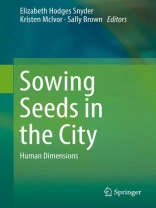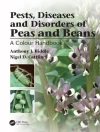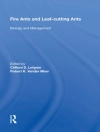A majority of the world’s population lives in cities. Urban areas have largely been disconnected from the processes associated with producing food. A broad range of community efforts have emerged to reconnect people in urban areas to fresh foods with expected benefits for public health. These efforts can be found in cities across the country and cross both economic and ethnic lines. They have been led by the non- scientific community and are best characterized as social movements. Expansion of agriculture to non- traditional areas including community or kitchen gardens in urban or peri- urban environments has the potential to provide a range of ecosystem services as well as reduce stressors on non- urban environments. These services/benefits include improved public health, improved human nutrition and diet, large-scale production of renewable resources, increased food security with less resilience on traditional agricultural landscapes and seascapes, enhanced ecosystem function in urban areas, and increased public appreciation for and understanding of ecosystem services.
Cuprins
Preface.- Chapter 1, Introduction: Faces of Agriculture.- Part I: Perspectives on Food Security and the Impacts of Urban Agriculture.- Chapter 2. Food Security and Urban Agriculture.- Chapter 3. Urban Agriculture as a Resiliency Strategy.-Chapter 4. The Long Tradition of Urban Agriculture in the U.S. – and its Future.- Part II: Individual and Community Health Benefits of Urban Agriculture.- Chapter 5. Harvesting Health in the Garden.- Chapter 6. Social Health and Social Capital.- Chapter 7. Urban Gardening Practices and Culture.- Chapter 8. Nature Contact, Health, and the Built Environment.- Chapter 9. A Case Study: The Discourse of Obesity and Public Health in Planning and Participation in New York City Gardens.- Part III: Managing the Risks of Urban Agriculture.- Chapter 10. Assessing and Communicating the Risks (and Benefits) of Community Participation in Urban Agriculture.- Chapter 11. Modeling to Predict High Pb Areas.- Chapter 12. Screening for Soil Lead Using a Common Soil Test Method.- Chapter 13. Mechanisms to Reduce Risk Potential.- Chapter 14. A Case Study: Potential Health Risks Posed by Eating Eggs from Free Range Chickens in New York City.- Part IV: Democracy, Ethics, and Sovereignty in Urban Agriculture.- Chapter 15. Common Roots: Urban Agriculture’s Potential for Cultivating Deep Democracy.- Chapter 16. Ethics of Urban Agriculture.- Chapter 17. A Case Study of Spatial and Economic Sovereignty: Reclaiming Space and Building Community in Philadelphia One Vacant Lot at a Time.- Part V: Research on Urban Agriculture and Food Security.- Chapter 18. Case Studies of Urban Food Security Research: A Focus on Methodology.- Chapter 19. A Case Study: Native Perspectives of Gardening.- Chapter 20. A Case Study on Learning Gardens in an Urban Indigenous Community: Expanding the Scope of Learning.- Chapter 21. A Case Study: Growing Community Through Gardens on Chicago’s Southwest Side.- Part VI: Urban Agriculture Programming and Education – Non-Profit Organizations.- Chapter 22. Intense Urban Agriculture as a Tool to Educate and Build Communities: A Glance at What Farmer Frog is Doing in the Pacific Northwest.- Chapter 23. Ranier Beach Urban Farm and Wetlands: Urban Farm Enterprise Creates Community Connections.- Chapter 24. Everyone at the Table: A Case Study of Garden-Raised Bounty (GRu B).- Chapter 25. Seattle Youth Garden Works Empowers Urban Youth.- Chapter 26. Community Managed Open Space: A Case Study of Community Greening Resource Network, Baltimore, MD.- Part VII: Urban Agriculture Programming and Education: Cities, Universities, Entrepreneurs, and Religious Groups.- Chapter 27. Adult Education: A For-Profit Model at the Williams Street Farmhouse.- Chapter 28. Washington State University Pierce County Extension Master Gardener program: Volunteer Educators in Home Gardening and Environmental Stewardship.- Chapter 29. Seeds of Hope: An Integrated Vision of the Role of Agriculture for the Episcopal Diocese of Los Angeles.- Chapter 30. Sustainability in Prisons Project (SPP) Horticulture Programs.- Chapter 31. A Case Study: Integrating Urban Agriculture into the Municipal Infrastructure in Tacoma, WA.
Preface
Chapter 1, Introduction: Faces of Agriculture; Bill Yosses
Part I: Perspectives on Food Security and the Impacts of Urban Agriculture
Chapter 2. Food Security and Urban Agriculture; Angie Tagtow
Chapter 3. Urban Agriculture as a Resiliency Strategy; Steve Hallett
Chapter 4. The Long Tradition of Urban Agriculture in the U.S. – and its Future; Ken Meter
Part II: Individual and Community Health Benefits of Urban Agriculture
Chapter 5. Harvesting Health in the Garden; Katherine Alaimo, Caroline Crawford, and Liz Snyder
Chapter 6. Social Health and Social Capital; Caroline Crawford and Katherine Alaimo
Chapter 7. Urban Gardening Practices and Culture; Nancy Nix
Chapter 8. Nature Contact, Health, and the Built Environment; Jerry Smith
Chapter 9. A Case Study: The Discourse of Obesity and Public Health in Planning and Participation in New York City Gardens; Yolanda Gonzalez, Matthew Potteigger, Anne Bellows, Evan Weissman, and Carolin Mees
Part III: Managing the Risks of Urban Agriculture
Chapter 10. Assessing and Communicating the Risks (and Benefits) of Community Participation in Urban Agriculture; John F. Obrycki and Liz Snyder
Chapter 11. Modeling to Predict High Pb Areas; Kirsten Schwarz
Chapter 12. Screening for Soil Lead Using a Common Soil Test Method; John Obrycki, Kristen K. Minca, Nicholas T. Basta
Chapter 13. Mechanisms to Reduce Risk Potential; Ganga M. Hettiarachchi, Chammi P. Attanayake, Philip P. Defoe, and Sabine E. Martin
Chapter 14. A Case Study: Potential Health Risks Posed by Eating Eggs from Free Range Chickens in New York City; Henry M. Spliethoff
Part IV: Democracy, Ethics, and Sovereignty in Urban Agriculture
Chapter 15. Common Roots: Urban Agriculture’s Potential for Cultivating Deep Democracy; David W. Mc Ivor and James Hale
Chapter 16. Ethics of Urban Agriculture; Gavin Van Horn
Chapter 17. A Case Study of Spatial and Economic Sovereignty: Reclaiming Space and Building Community in Philadelphia One Vacant Lot at a Time; Brandon Hoover
Part V: Research on Urban Agriculture and Food Security
Chapter 18. Case Studies of Urban Food Security Research: A Focus on Methodology; Shannon Donovan, Liz Snyder, Renata Ballesteros-Lopez, Liza Root, Shaina Seidner, and Carol Mc Carty
Chapter 19. A Case Study: Native Perspectives of Gardening; Megan Bang
Chapter 20. A Case Study on Learning Gardens in an Urban Indigenous Community: Expanding the Scope of Learning; Megan Bang
Chapter 21. A Case Study: Growing Community Through Gardens on Chicago’s Southwest Side; Nicole Llorens-Monteserin and Howard Rosing
Part VI: Urban Agriculture Programming and Education – Non-Profit Organizations
Chapter 22. Intense Urban Agriculture as a Tool to Educate and Build Communities: A Glance at What Farmer Frog is Doing in the Pacific Northwest; Zsofia Pasztor
Chapter 23. Ranier Beach Urban Farm and Wetlands: Urban Farm Enterprise Creates Community Connections; Katie Pencke
Chapter 24. Everyone at the Table: A Case Study of Garden-Raised Bounty (GRu B); Katie Rains
Chapter 25. Seattle Youth Garden Works Empowers Urban Youth; Tyler Hughes
Chapter 26. Community Managed Open Space: A Case Study of Community Greening Resource Network, Baltimore, MD; Sarah Krones
Part VII: Urban Agriculture Programming and Education: Cities, Universities, Entrepreneurs, and Religious Groups
Chapter 27. Adult Education: A For-Profit Model at the Williams Street Farmhouse; Saskia Esslinger
Chapter 28. Washington State University Pierce County Extension Master Gardener program: Volunteer Educators in Home Gardening and Environmental Stewardship; Kerri Wilson
Chapter 29. Seeds of Hope: An Integrated Vision of the Role of Agriculture for the Episcopal Diocese of Los Angeles;
Chapter 30. Sustainability in Prisons Project (SPP) Horticulture Programs; Joslyn Trivett, Kelli Bush, Carol Elliott, Jaal Mann, Rodney Pond, Ed Tharp, Julie Vanneste, Dan Pacholke, and Carrie Le Roy
Chapter 31. A Case Study: Integrating Urban Agriculture into the Municipal Infrastructure in Tacoma, WA; Sally Brown
Despre autor
Elizabeth Hodges Snyder is an Assistant Professor of Public Health and the Master of Public Health Program Coordinator at the University of Alaska Anchorage. She also serves as co-chair of the Alaska Food Policy Council (AFPC). Dr. Snyder is trained in environmental health (MPH, Global Environmental Health, Emory University, 2004) and soil and water science (Ph D, Soil and Water Science, University of Florida, 2009). Her career began with a focus on environmental contaminant fate and transport, and human and ecological risk assessment, but her research program and teaching agenda has since evolved to address the fields of food security and health impact assessment. She has co-authored several works on food security in Alaska; supervises graduate student projects addressing food access, availability, and utilization; and advocates for strengthened rural and urban food systems. Originally from Florida, Dr. Snyder has adjusted well to the climate of Alaska – successfully raising backyard chickens, utilizing vertical drip irrigation to produce greenhouse tomatoes, growing beautiful peonies, chasing moose out of her raised beds, and instilling in her children a love for Alaska Grown carrots made sugar-sweet in the cold soil.
Kristen Mc Ivor is the director of Harvest Pierce County, a program of the Pierce Conservation District. Their mission is to invest in people to foster and sustain an equitable and healthy community-based food system throughout Pierce County. She is also an adjunct professor at Antioch University Seattle where she teaches classes on food systems. Dr. Mc Ivor got her MS at Antioch in Environment and Community and her Ph D at the University of Washington. Her academic work has focused on improving soils in urban areas to support the growing of food, and much of her time is spent working with community groups to do just that. She lives in the drippy Pacific Northwest and loves its mild climate for year-round growing. In her spare time, she gets her hands dirty as often as she can, and loves preparing and sharing the bounty of her garden with her family and friends.
Sally L Brown is a Research Associate Professor at the University of Washington School of Forest and Environmental Science. She is a Fellow in the Soil Science Society of America, was a two- term member of the National Academy of Science Standing Committee on Soil Science and a member on the National Academy of Science Committee on the Bioavailability of Contaminants in Soils and Sediments. She has won multiple awards for her work on residuals use in soils. Dr. Brown writes a monthly column for Biocycle Magazine, a journal that focuses on sustainable management of organics. She has a BA in Political Science from Williams College (1980) and a MS (1993) and Ph D (1996)from the University of Maryland. Before returning to graduate school, she worked as a chef in New York City, New Orleans and Connecticut. In 1986 she started a business delivering locally grown vegetables to stores and restaurants in New York City and Connecticut. She currently grows greens, onions, potatoes and currants on two plots near her home with the assistance of her husband and Tagro, the biosolids based soil amendment from Tacoma, WA.












